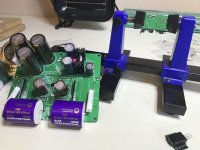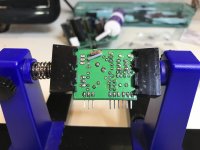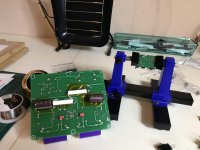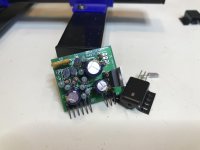I recently purchased a Focusrite Scarlett Solo and downloaded a copy of REW and ARTA to perform my own measurements and see what changes happen when components are altered.
First a thank you to the concept of DBs for this build. I had purchased some of the Toshiba transistors and so easy to swap out transistors on the four DBs. Unplug them from the MB and easy access.
My initial build used a lower value for R9, with the REW I was able to observe the H3 was more than the H2. I am a fan of how the H2 sounds, so a simple swap on R9 and now a more dominate H2. Yes a good purchase.
Now for the question on using REW, not sure of the proper settings here. Each time it resamples the display raises and lowers and shows something different, then back around. Suggestions, thoughts.
Thanks
David
First a thank you to the concept of DBs for this build. I had purchased some of the Toshiba transistors and so easy to swap out transistors on the four DBs. Unplug them from the MB and easy access.
My initial build used a lower value for R9, with the REW I was able to observe the H3 was more than the H2. I am a fan of how the H2 sounds, so a simple swap on R9 and now a more dominate H2. Yes a good purchase.
Now for the question on using REW, not sure of the proper settings here. Each time it resamples the display raises and lowers and shows something different, then back around. Suggestions, thoughts.
Thanks
David
Haha, glad you got the RCA's figured out!
I have the 8 pin cable and the 8 pin connector is on the way. I think I need to review which connectors I think I need again when I get back in front of the board.
Cheers,
Gable
Gable,
Any progress on your build? I'm curious to know if you are up and running and how the Toshibas are working with the mods to R14 and R15. I'm about to attempt the same configuration. Hoping to get some soldering time in this weekend.
I haven't had much time to work on it, but I have made a bit of progress.
The last film caps came in and I got those mounted, I moved some of them and some of the electrolytics to the bottom of the board to leave room for the heatsinks on the daughterboards.
I'm moving the daughterboard resistors R12, R14, R15, and R16 to the rear of the board, laid over to allow room for the heatsinks I have on hand. I think I will have just enough room to make it all work.
I wont be able to work on it for another week or so, as we're traveling to Norway this Saturday.
I'm still trying to figure out a good case for it as well. I may just design some front/rear panels and have Front Panel Express make them, maybe I can modify a HiFi2000 case...
Hope you get some solder slinging time soon!
Cheers,
Gable
The last film caps came in and I got those mounted, I moved some of them and some of the electrolytics to the bottom of the board to leave room for the heatsinks on the daughterboards.
I'm moving the daughterboard resistors R12, R14, R15, and R16 to the rear of the board, laid over to allow room for the heatsinks I have on hand. I think I will have just enough room to make it all work.
I wont be able to work on it for another week or so, as we're traveling to Norway this Saturday.
I'm still trying to figure out a good case for it as well. I may just design some front/rear panels and have Front Panel Express make them, maybe I can modify a HiFi2000 case...
Hope you get some solder slinging time soon!
Cheers,
Gable
Attachments
Good progress Pcgab. Have fun in Norway - vacation or work?
Vacation for me. My wife has to go for some company meetings, so I got a ticket to tag along. I'm going to see some museums, eat as much reindeer as I can, and run back and forth from the sauna to the cold as hell ocean
Looks like there are some hifi stores around Bergen, so I may have to check them out as well.
Unfortunately I won't be able to do Trolltunga solo, as it's snowshoe and guide required this time of year.
Trolltunga
Bergen Water Temperature | Norway Sea Temperatures
Holy hell, water temperature is ~6c (~42f)..... wow, that's really cold. I guess I'll have to make my forays into the ocean very, _very_ brief.
Cheers,
Gable
This is one person's thoughts on the AKSA-Lender, the Nelson BA-3 and the Yaniger ImPasse preamps. The amps being used are a pair of bridged Pass designed F4. The F4 amps need a preamp with a larger output voltage than most preamps can deliver. The three listed above are capable of the necessary output.
My first DIY build began in 2014 was the BA-3 followed by one F4. I liked that combination so well I build another F4. The ImPasse was something I wanted to try and finally late last year purchased the boards and input transformers from Jack. Then Hugh delivers his AKSA-Lender preamp to the community and I wanted to try it also with the F4 amps.
Please keep in mind these are my thoughts using this three preamps and your listening experiences will vary, due to variances in the builds, your listening space and choice of speakers.
My BA-3 build uses a single toroidal transformer into a Salas shunt regulator. The BA-3 has genuine Toshiba transistors and I am using 10uf Mundorf SIO caps on the outputs with Goldpoint pot and selector. Using the P3 adjustment, the second harmonic has a negative phase. The AKSA-Lender was built from the BOM listing from that thread. I chose R9 for a more dominate second harmonic. Finally the ImPasse was also built using the BOM from that thread. I did do some tube rolling, started with Electro Harmonix and really didn't like the sound. Finally ended with some NOS RCA and Amperex tubes.
I am using a Pink Floyd song from their 1973 album "Dark Side of the Moon". That song is " The Great Gig in the Sky". The instruments are a piano, Hammond organ, pedal steel guitar, bass, and drums. The main vocals are supplied in an almost orgasmic way by Clare Torry. Her wailing reveals much about the preamps. Also I listened to the live version of Dave Brubeck's "Take Five" from the album "Concord on a Summer Night".
BA-3 preamp
A nice wide sound stage, with the pedal steel guitar coming more from the right side. Good depth with the vocal and drums coming from the rear. Cymbals are crisp. In the second set of vocals distinct sounding. The piano sounds very smooth and rounded. There is a nice sonic balance with the bass.
AKSA-Lender preamp
Also a wide sound stage. The pedal steel is not as defined as the BA-3. Cymbals have a nice sizzle. The Hammond organ is distinct and the vocals are more forward sounding. Drums are also very defined.
ImPasse preamp
Another wide sound stage. The piano and pedal steel are well defined. Vocal appears from upper left with the bass more defined. Cymbal also with nice sizzle sound. In the second set of vocals there is a nice balance with the piano. For me the vocals were not as clearly defined as the two solid stage preamps.
Finally the question would be which is best/sounds better, etc. For me there is a personal enjoyment when listening with each preamp at different times with different music. Ok, my order of preference would be the BA-3, AKSA-Lender, and ImPasse. I believe both solid state preamps have a slight edge over the tube preamp. Finally if you want to look at cost and versatility then the AKSA-Lender has both of the others beat for price and convenience. In my opinion it offers the most bang for the money.
So final thoughts, any of these preamps would be great with the Pass F4 amps. My wife and I for the past twenty years have been involved with retired racing greyhound adoption. In that adoption world, there is a catch phrase that is applicable to the DIY audio world. It is "they are like potato chips, it's hard to stop with only one". True for the greyhounds and so true for the DIY audio world. All I can say is build and enjoy.
Thanks
David
My first DIY build began in 2014 was the BA-3 followed by one F4. I liked that combination so well I build another F4. The ImPasse was something I wanted to try and finally late last year purchased the boards and input transformers from Jack. Then Hugh delivers his AKSA-Lender preamp to the community and I wanted to try it also with the F4 amps.
Please keep in mind these are my thoughts using this three preamps and your listening experiences will vary, due to variances in the builds, your listening space and choice of speakers.
My BA-3 build uses a single toroidal transformer into a Salas shunt regulator. The BA-3 has genuine Toshiba transistors and I am using 10uf Mundorf SIO caps on the outputs with Goldpoint pot and selector. Using the P3 adjustment, the second harmonic has a negative phase. The AKSA-Lender was built from the BOM listing from that thread. I chose R9 for a more dominate second harmonic. Finally the ImPasse was also built using the BOM from that thread. I did do some tube rolling, started with Electro Harmonix and really didn't like the sound. Finally ended with some NOS RCA and Amperex tubes.
I am using a Pink Floyd song from their 1973 album "Dark Side of the Moon". That song is " The Great Gig in the Sky". The instruments are a piano, Hammond organ, pedal steel guitar, bass, and drums. The main vocals are supplied in an almost orgasmic way by Clare Torry. Her wailing reveals much about the preamps. Also I listened to the live version of Dave Brubeck's "Take Five" from the album "Concord on a Summer Night".
BA-3 preamp
A nice wide sound stage, with the pedal steel guitar coming more from the right side. Good depth with the vocal and drums coming from the rear. Cymbals are crisp. In the second set of vocals distinct sounding. The piano sounds very smooth and rounded. There is a nice sonic balance with the bass.
AKSA-Lender preamp
Also a wide sound stage. The pedal steel is not as defined as the BA-3. Cymbals have a nice sizzle. The Hammond organ is distinct and the vocals are more forward sounding. Drums are also very defined.
ImPasse preamp
Another wide sound stage. The piano and pedal steel are well defined. Vocal appears from upper left with the bass more defined. Cymbal also with nice sizzle sound. In the second set of vocals there is a nice balance with the piano. For me the vocals were not as clearly defined as the two solid stage preamps.
Finally the question would be which is best/sounds better, etc. For me there is a personal enjoyment when listening with each preamp at different times with different music. Ok, my order of preference would be the BA-3, AKSA-Lender, and ImPasse. I believe both solid state preamps have a slight edge over the tube preamp. Finally if you want to look at cost and versatility then the AKSA-Lender has both of the others beat for price and convenience. In my opinion it offers the most bang for the money.
So final thoughts, any of these preamps would be great with the Pass F4 amps. My wife and I for the past twenty years have been involved with retired racing greyhound adoption. In that adoption world, there is a catch phrase that is applicable to the DIY audio world. It is "they are like potato chips, it's hard to stop with only one". True for the greyhounds and so true for the DIY audio world. All I can say is build and enjoy.
Thanks
David
Thank you for the thoughtful review, DrPro. You turned me onto the Great Gig in the Sky.
I have another one for you to try:
The Who, “See Me, Feel Me” from Tommy. In high res flac from good source is truly epic sounding. Great dynamic range, low noise, superb recording for 1969.
I have another one for you to try:
The Who, “See Me, Feel Me” from Tommy. In high res flac from good source is truly epic sounding. Great dynamic range, low noise, superb recording for 1969.
This is one person's thoughts on the AKSA-Lender, the Nelson BA-3 and the Yaniger ImPasse preamps. The amps being used are a pair of bridged Pass designed F4. The F4 amps need a preamp with a larger output voltage than most preamps can deliver. The three listed above are capable of the necessary output.
My first DIY build began in 2014 was the BA-3 followed by one F4. I liked that combination so well I build another F4. The ImPasse was something I wanted to try and finally late last year purchased the boards and input transformers from Jack. Then Hugh delivers his AKSA-Lender preamp to the community and I wanted to try it also with the F4 amps.
Please keep in mind these are my thoughts using this three preamps and your listening experiences will vary, due to variances in the builds, your listening space and choice of speakers.
My BA-3 build uses a single toroidal transformer into a Salas shunt regulator. The BA-3 has genuine Toshiba transistors and I am using 10uf Mundorf SIO caps on the outputs with Goldpoint pot and selector. Using the P3 adjustment, the second harmonic has a negative phase. The AKSA-Lender was built from the BOM listing from that thread. I chose R9 for a more dominate second harmonic. Finally the ImPasse was also built using the BOM from that thread. I did do some tube rolling, started with Electro Harmonix and really didn't like the sound. Finally ended with some NOS RCA and Amperex tubes.
I am using a Pink Floyd song from their 1973 album "Dark Side of the Moon". That song is " The Great Gig in the Sky". The instruments are a piano, Hammond organ, pedal steel guitar, bass, and drums. The main vocals are supplied in an almost orgasmic way by Clare Torry. Her wailing reveals much about the preamps. Also I listened to the live version of Dave Brubeck's "Take Five" from the album "Concord on a Summer Night".
BA-3 preamp
A nice wide sound stage, with the pedal steel guitar coming more from the right side. Good depth with the vocal and drums coming from the rear. Cymbals are crisp. In the second set of vocals distinct sounding. The piano sounds very smooth and rounded. There is a nice sonic balance with the bass.
AKSA-Lender preamp
Also a wide sound stage. The pedal steel is not as defined as the BA-3. Cymbals have a nice sizzle. The Hammond organ is distinct and the vocals are more forward sounding. Drums are also very defined.
ImPasse preamp
Another wide sound stage. The piano and pedal steel are well defined. Vocal appears from upper left with the bass more defined. Cymbal also with nice sizzle sound. In the second set of vocals there is a nice balance with the piano. For me the vocals were not as clearly defined as the two solid stage preamps.
Finally the question would be which is best/sounds better, etc. For me there is a personal enjoyment when listening with each preamp at different times with different music. Ok, my order of preference would be the BA-3, AKSA-Lender, and ImPasse. I believe both solid state preamps have a slight edge over the tube preamp. Finally if you want to look at cost and versatility then the AKSA-Lender has both of the others beat for price and convenience. In my opinion it offers the most bang for the money.
So final thoughts, any of these preamps would be great with the Pass F4 amps. My wife and I for the past twenty years have been involved with retired racing greyhound adoption. In that adoption world, there is a catch phrase that is applicable to the DIY audio world. It is "they are like potato chips, it's hard to stop with only one". True for the greyhounds and so true for the DIY audio world. All I can say is build and enjoy.
Thanks
David
Nice write-up. That's what i want to use is an SSLV1.1 with mine. I hope Tea-bags has got some boards left!!!!!!!
One doubt .. from reading about different topologies, it seems single ended stages gives more 2nd harmonics and symmetrical stages with n and p fets or npn and PNP transistor gives 3rd harmonics . And also the LTP stage cancels even harmonics and gives more odd harmonics..I do try to use single ended front ends, I do not like symmetrical input stages. They tend to depress even harmonics, and bring out the odds. SE topologies bring up evens, particularly H2 and H4, and usually bring much more THD in as well, but it's not 'machine' tones, like H5, H7 etc.
Hugh
So here are we getting odd harmonics from input LTP stage and 2nd harmonics from Q3 or output stage ??
One doubt .. from reading about different topologies, it seems single ended stages gives more 2nd harmonics and symmetrical stages with n and p fets or npn and PNP transistor gives 3rd harmonics . And also the LTP stage cancels even harmonics and gives more odd harmonics..
So here are we getting odd harmonics from input LTP stage and 2nd harmonics from Q3 or output stage ??
Note that Aksa Lender is LTP input, but with a twist - it behaves like a SE input in harmonic profile, but with a lot less THD like a standard LTP. Best of both worlds.
Anytime there is less mirror symmetry, H(even) will be higher.
The original Lender circuit was a combined creation of Borbely and Lender in Switzerland almost sixty years ago. They used two opposite gender as the VAS; one driven at base from the left leg of the LTP and the other driven at emitter from the right leg of the LTP. My approximation is almost trivial; it's more an asymmetrical current mirror with free collector taken to the next stage; in this role tethered to an emitter follower at the convenient base emitter resistor comprising a CCS.
In that sense its a modded Borbeley-Lender, but I am attracted to driving both sides of a common emitter because the additional diode relieves the drive at the base, transferring much of the drive to the emitter and this, as a hybrid common emitter/common base transistor it is very, very fast. The additional speed flattens the phase shift and pushes up the high pole.
If we drop Q4, as Juma suggests, we must drive the VAS at 12mA to equal the drive capacity and in truth it's always advantage to drive an output stage at an emitter, since Zout is 26/mA, only 2R intrinsic here sinking current. A VAS collector has very high intrinsic impedance, and the base current is high; say 70uA, using a TO126 VAS, say a KSC2682 or a 2SC3423. The TO92 low parasitic KSA1845 has higher beta and running at 1.5mA the Ib is typically 7uA, unloading the LTP hugely.
Again, a real compromise, somewhat an art, and this seems to perform very well with very low distortion and intrinsic THD 0.143%, H2 at -57dB - gain of 73.8dB without fb at all. This is a very good base from which to add global feedback, and the speed assures easy compensation and wide, deep sound field.
Thanks for the interest. This is a thought experiment for me but if someone builds I'd be very interested in their SQ findings.
HD
One doubt.. is the role of Q3 is of VAS ie voltage amplifier (common emitter config loaded by constant current source) and Q4 being in common collector config loaded by constant current source , doing current amplification and lower output impedance?
and both Q3 and Q4 using same constant current source..
ie is it like a LTP input stage followed by a voltage amplification stage and then current amplification stage??
Just wanted to let folks know that I now have more Aksa Lender Preamp MB’s and TH DB’s in stock. Please order through my shop in signature. The TH setup as a HPA is quite formidable. Listening tests vs other amps shows that this one, has some guts and is very natural sounding. Still works great as a Preamp in HPA attire.
- Home
- Source & Line
- Analog Line Level
- AKSA's Lender Preamp with 40Vpp Output



